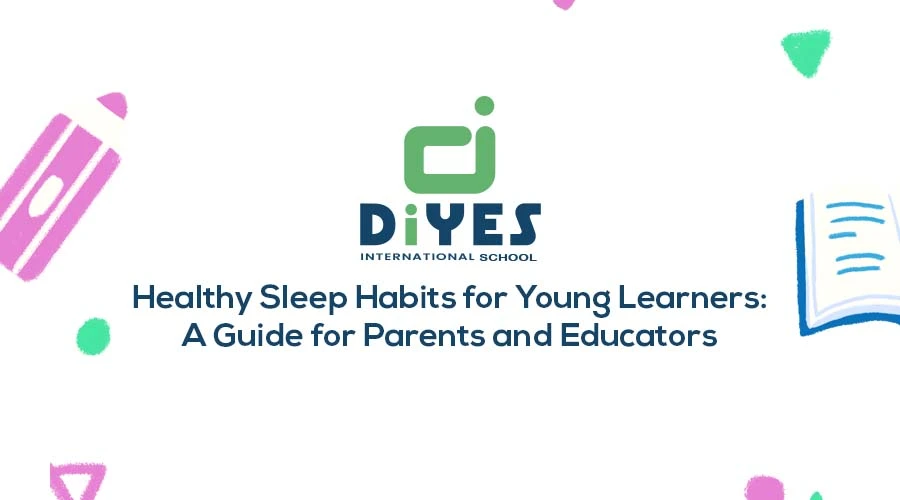In the intricate tapestry of childhood development, the role of quality sleep stands as a cornerstone. As young learners navigate the terrain of growth and learning, ensuring they receive sufficient and restorative sleep is pivotal for their physical health, cognitive development, and emotional well-being.

Embark on a journey into the realm of healthy sleep habits, unraveling the profound impact of quality sleep on the holistic development of young learners. This exploration delves into the significance of healthy sleep habits, offering a comprehensive guide for parents and educators seeking to optimize the sleep environment for young minds. From understanding the sleep requirements for different age groups to implementing effective bedtime routines, this guide explores practical strategies for creating an optimal sleep environment.
The Sleep Blueprint: Understanding Age-Appropriate Requirements
The foundation of healthy sleep habits begins with a profound understanding of age-appropriate sleep requirements. Tailoring sleep patterns to align with the distinct needs of different age groups is crucial for fostering optimal physical and cognitive development in young learners.
a) Infants (0–12 Months): Infants experience significant growth and development, requiring up to 14–17 hours of sleep per day. Understanding the sleep-wake cycles and establishing consistent bedtime routines are key to promoting healthy sleep in this age group.
The sleep needs of infants undergo rapid changes during their first year of life. Newborns (0–3 months) require the highest amount of sleep, ranging from 14 to 17 hours per day. As they progress into the 4–11-month age group, the total sleep hours reduce slightly to 12–15 hours. Establishing a consistent bedtime routine, incorporating calming activities, and creating a quiet sleep environment are foundational elements for promoting healthy sleep in infants. Understanding and respecting their natural sleep-wake cycles contributes to nurturing a restful sleep routine.
b) Toddlers (1–2 Years): Toddlers typically need 11–14 hours of sleep, including naps. Introducing a consistent bedtime routine and creating a conducive sleep environment contribute to sound and restful sleep for toddlers.
Toddlers continue to benefit from a substantial amount of sleep, needing approximately 11–14 hours per day, inclusive of naps. Consistency is key to promoting healthy sleep habits for toddlers. Introducing a bedtime routine that includes calming activities, such as reading or gentle music, signals to the toddler that it is time to wind down. Creating a sleep environment that is comfortable, dark, and quiet contributes to a restful night’s sleep. Naps are still an integral part of their sleep routine, with one to two naps recommended.
The Sleep Environment: Crafting a Haven for Restful Nights
The sleep environment plays a pivotal role in shaping the quality of a child’s sleep. Crafting a haven for restful nights involves considerations such as ambient lighting, comfortable bedding, and the elimination of sleep disruptors to ensure an optimal sleep sanctuary.
a) Ambient Lighting and Darkness: The role of light and darkness in regulating sleep-wake cycles is crucial. Dimming lights during the bedtime routine and ensuring complete darkness during sleep hours contribute to a conducive sleep environment.
The human circadian rhythm is influenced by exposure to light and darkness, making it essential to manage ambient lighting for quality sleep. During the bedtime routine, gradually dimming lights signal to the body that it’s time to wind down. Once asleep, the sleep environment should be as dark as possible to enhance melatonin production, a hormone crucial for regulating sleep. Utilizing blackout curtains or shades can effectively block external light sources, creating an optimal sleep sanctuary.
b) Comfortable Bedding and Sleepwear: Creating a comfortable sleep environment involves selecting appropriate bedding and sleepwear. Opting for breathable fabrics, maintaining a comfortable room temperature, and avoiding excessive layers contribute to a restful night’s sleep.
Creating a comfortable sleep environment involves thoughtful choices in bedding and sleepwear. Opting for breathable fabrics, such as cotton, promotes airflow and prevents overheating during the night. Maintaining a comfortable room temperature, typically between 60 and 67°F (15 and 20°C), further enhances the sleep environment. Avoiding excessive layers of bedding and choosing sleepwear that suits the room temperature contributes to a comfortable and restful night’s sleep for young learners.
Bedtime Routines: Establishing Consistency and Comfort
Bedtime routines serve as a bridge between wakefulness and rest, guiding young minds into the realm of peaceful sleep. Establishing consistent and calming bedtime rituals contributes to a smooth transition, signaling to the child that it’s time to unwind and embrace a night of rejuvenating rest.
a) Reading Rituals: Incorporating reading into the bedtime routine offers a calming and enjoyable activity. Engaging in storytelling or reading together not only promotes literacy but also creates a serene atmosphere conducive to sleep.

Introducing reading as a bedtime ritual not only supports language development but also provides a soothing transition to sleep. Selecting age-appropriate books and engaging in storytelling or reading together creates a serene atmosphere. The rhythmic cadence of a bedtime story can have a calming effect, making it an ideal activity for winding down. As part of the routine, parents or educators can encourage the child to select a book, fostering a sense of autonomy and participation in the bedtime ritual.
b) Calming Activities: Activities such as gentle music, soft lullabies, or a warm bath can be incorporated into the bedtime routine to induce relaxation. Consistency in these calming rituals establishes a predictable pattern for sleep.
Incorporating calming activities into the bedtime routine sets the stage for a restful night’s sleep. Gentle music, soft lullabies, or a warm bath can be included to induce relaxation. These activities create a predictable pattern that signals to the child that it’s time to unwind and prepare for sleep. Consistency in these calming rituals establishes a sense of security and comfort, reinforcing the association between these activities and the onset of sleep.
Digital Detox: Mitigating the Impact of Screen Time on Sleep
In the age of technology, managing screen time is integral to safeguarding the sleep quality of young learners. Mitigating the impact of electronic devices on sleep involves implementing a digital detox routine and establishing boundaries to create an optimal sleep-friendly environment.
a) Blue Light Exposure: The blue light emitted by screens can interfere with the production of melatonin, affecting the natural sleep-wake cycle. Implementing a screen curfew and reducing exposure to screens before bedtime contribute to improved sleep quality.
The prevalence of screens in daily life exposes young learners to blue light emitted by devices such as smartphones, tablets, and computers. Exposure to blue light inhibits the secretion of melatonin, a hormone essential for the regulation of sleep. To mitigate the impact of blue light on sleep, implementing a screen curfew is crucial. This involves setting a specific time before bedtime when all electronic devices are turned off. Reducing exposure to screens at least an hour before bedtime allows the body to naturally transition into sleep mode, enhancing the quality of sleep.
b) Establishing Screen-Free Zones: Designating specific areas, such as the bedroom, as screen-free zones promote a healthier sleep environment. This practice reinforces the association between the bedroom and sleep, minimizing distractions.
Creating designated screen-free zones, especially in areas associated with sleep, reinforces the connection between the environment and the intended activity. The bedroom, in particular, should be a screen-free zone to minimize distractions and create a space dedicated to rest. This practice helps cultivate a healthy sleep routine by removing the stimulating effects of screens, allowing young learners to unwind and relax in preparation for sleep.
Quality Sleep and Cognitive Development: The Interplay Unveiled
The relationship between quality sleep and cognitive development is profound. Understanding the interplay between sufficient and restorative sleep and cognitive functions sheds light on the importance of prioritizing sleep for young learners.
a) Memory Consolidation: Quality sleep plays a pivotal role in memory consolidation, a process where the brain strengthens and stabilizes newly acquired information. Sufficient sleep enhances the ability to retain and recall information.

One of the fundamental roles of sleep in cognitive development is memory consolidation. During sleep, especially in the deep sleep stages, the brain processes and consolidates information acquired throughout the day. This process strengthens neural connections, enhancing the ability to retain and recall information. For young learners engaged in continuous learning experiences, prioritizing sufficient and uninterrupted sleep is essential to support memory consolidation and optimal cognitive function.
b) Executive Function: The executive functions of the brain, including decision-making, problem-solving, and impulse control, are intricately linked to sleep quality. Prioritizing sleep contributes to the development and refinement of these critical cognitive skills.
The executive functions of the brain encompass a range of cognitive processes, including decision-making, problem-solving, and impulse control. Quality sleep is closely linked to the development and refinement of these critical skills. Adequate sleep allows the brain to regulate and optimize executive functions, contributing to improved cognitive performance. Young minds benefit from enhanced decision-making abilities, problem-solving skills, and the capacity for focused attention when provided with consistent and high-quality sleep.
Conclusion: A Rested Beginning for a Bright Tomorrow
In the grand symphony of early learning, the melody of healthy sleep resonates as a key determinant of a child’s overall well-being and cognitive development. From understanding the distinct sleep needs of different age groups to crafting an optimal sleep environment and embracing bedtime routines, the guide to healthy sleep habits for young learners encompasses a holistic approach. As parents, educators, and caregivers, the responsibility to nurture the sleep habits of young minds is a profound opportunity to shape the foundation of a bright and promising future.
At DiYES International School, we go beyond the conventional approach to education, placing a premium on the holistic development of young learners. Recognizing the intrinsic connection between quality sleep and cognitive well-being, we prioritize creating an environment that fosters not only academic excellence but also the overall health and happiness of our students. Our commitment extends to providing a nurturing space where the importance of quality sleep is woven into the fabric of our educational philosophy.
In our endeavour to prepare students for a future that demands resilience, creativity, and cognitive acuity, we understand the pivotal role that healthy sleep habits play in their success. As part of our holistic approach, we work collaboratively with parents, educators, and caregivers to instill the value of a balanced lifestyle, including the cultivation of healthy sleep patterns. Through a combination of personalized attention, engaging learning environments, and a commitment to well-being, DiYES International School stands as a beacon of excellence in nurturing not just bright minds but also well-rested, vibrant individuals ready to embrace the challenges and opportunities of tomorrow.
Explore more about our commitment to education at www.diyesinternational.edu.in or connect with us directly at +91 8547609000.


